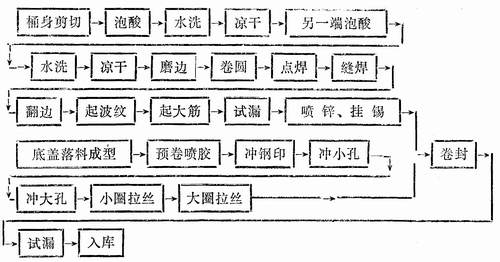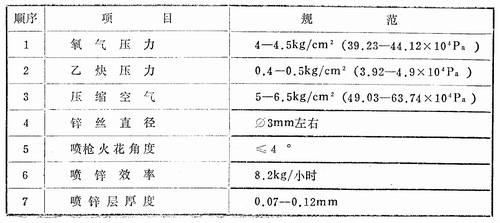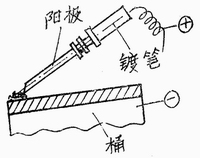Discussion on the technology of galvanized steel drum
Discussion on the technology of galvanized steel drum
Hainan Provincial Agricultural Reclamation Haikou Agricultural Tools Factory Ding Jinyi
The 200 litre galvanized steel drum is one of the important metal packaging containers. The demand on the market is also very large. Every year, a large number of galvanized steel drums are used to sell various products to domestic and foreign markets. In particular, foreign trade exports are more prominent, and many foreign exchanges are made for the country.
The galvanized steel drum has the advantages of good corrosion resistance, no need for painting on the inner and outer surfaces, and good appearance quality. At present, there are two main production processes for domestic 200 liter galvanized steel drums. One is to process the cold (hot) rolled steel sheet into a semi-finished product, and then galvanize the final package. The other is directly processed into galvanized barrels from galvanized steel sheets. Both production processes have their own advantages and disadvantages. The production process of galvanized steel drums produced in northern and southern China is different. The first production process is generally adopted in the north, and the second production process is used in the south.
The cold (hot) rolled sheet is processed into a semi-finished sheet, and then galvanized, and the final packaging production process is as shown.
The advantage of this production process is that the galvanizing process is carried out after the seam welding, flanging, corrugation and large ribs of the barrel, avoiding the galvanized layer which is not hardened, and the galvanized layer is scraped during processing, especially during the edging process. Injury, bruises, and roll injuries. The disadvantage is that the transportation distance is long before and after electroplating, and it is easy to bump. If it is not carefully repaired before the seal, it will not only affect the appearance quality, but also affect the curling landscape.

Figure 1 Semi-finished galvanized barrel production process
The key to the above production process lies in the quality of the galvanized layer. For conditional barrel factories, as long as the environmental protection department approves, they can adopt the method of cyanide-free galvanizing. The plating tank used for the plating barrel can be made of a hard plastic plate of 10-20 mm, plus a steel frame. Also equipped with two clear water tanks. The sink can be made of cement. The rectifier used can be a thyristor rectifier. The output voltage does not exceed 12V. In order to ensure the quality of galvanizing, the workpiece must be pre-plated.
Commonly used pre-plating treatment methods are mechanical, chemical and electrochemical treatment methods. Mechanical treatment includes sand blasting, polishing, polishing, and the like. The chemical treatment can be treated with dilute hydrochloric acid, and the "three in one" and "four in one" treatment liquids can also be used. Pre-plating treatment directly affects the quality of the coating. Coating flatness, bonding strength, corrosion resistance and other properties are closely related to pre-plating treatment.
The current density used for galvanizing is generally 1.5 A/M2 and the current is 600-700 A. At present, there are many kinds of plating solutions for galvanizing. Commonly used are sulfate solution, ammonium citrate solution, sodium hydroxide solution, and potassium chloride (sodium) galvanizing solution.
It is generally easy to ensure the coating of the outer surface of the galvanized barrel. The inner surface, especially the large ribs, is not uniform due to uneven current density, so special hangers must be provided.
The galvanized barrel made of semi-finished galvanized method should check the quality of the galvanized layer. Generally, the surface of the galvanized layer is smooth, flat, and uniform in color. The coating should not be rough, and there are defects such as charring, pitting, black spots, blistering, falling off, surface dendrites, and spongy.
In order to check the quality of the coating, a sampling test can be carried out, and the following tests can generally be carried out:
1. Bending test: Take a 80×25mm galvanized sample, bend it by 180° (the minimum radius of curvature is 1mm) and level it to check if the zinc layer in the bend is peeling off.
2. Hot curve test: Take a piece of 80×25mm galvanized sample plate, heat it to 240°C, quickly put it into the cooling water, take it out after 1 minute, and check whether the zinc layer is falling off.
3. Impact test: Take a piece of 80×25mm galvanized sample, impact with a 50kg punching needle (the diameter of the punching needle is 1.5mm), and check whether the galvanized layer at the edge of the punching hole is detached.
The above galvanized barrel production process is a relatively mature production process, so many barrel factories, especially in the northern region, generally like to adopt this production process,
The second galvanized barrel production process is shown in Figure 2.

Figure 2 Production process of galvanized sheet drum
The advantage of this production process is that the semi-finished product is not electroplated. In areas where plating quality is not up to standard, this production process is ideal. At present, many barrel factories in southern China still use this production process. The disadvantage of this production process is that the galvanized steel drum is difficult to edging, that is, the zinc particles are easy to block the gap of the grinding wheel, so that the edging process cannot be carried out smoothly. Therefore, it is often necessary to increase the acidification process before edging.
The bubble acid is generally 10-15% dilute hydrochloric acid. After soaking the acid, it should be washed with water. It is best to wipe it with sand (smear several times in the sand tank with water). After cleaning, be sure to keep it cool and dry. In addition, the depth of the bubble is generally not more than 20 mm. It is necessary to prevent this hydrochloric acid gas from eroding the upper galvanized layer. Before the package, the inner surface of the barrel must be sprayed with zinc, tinned or otherwise treated.
Zinc-spraying uses an electric spray gun to adhere zinc powder to the barrel wall at high temperatures. In order to ensure the quality of zinc spray, the pre-sprayed surface must be roughened before spraying, and the surface moisture, grease, dirt, and oxide film should be removed together. General roughing can be sandblasted. Some chemical treatments also meet rough processing requirements. The sand is sent to the compressed air to cause it to be ejected from the nozzle, strongly impacting the impurities attached to the surface of the steel sheet, and roughening the surface.

Compressed air is generally separated and filtered by oil and water to keep it dry and clean. When spraying, the spray gun should be about 120~150mm from the surface of the barrel, and pay attention to the fineness of the particles at any time. Generally, the finer the better. After the zinc is sprayed, the particles splashed to other parts of the barrel are generally removed.
The biggest drawback of zinc spray is that the operator's working conditions are poor.
The damaged zinc layer can also be soldered with tin by means of hanging tin. The method is to solder the solder to the surface of the barrel that needs to be tinned with a soldering iron. Generally, tin bars of 65 or more are used. If the barrel is placed in a device with a heat source, it is better to preheat the part to be soldered; the front surface of the tin must be pretreated. It can be sandblasted or manually treated with a steel brush and then rinsed with water. After the seam welding, the flux used to hang the tin can be used as soon as possible. That is, the zinc sheet is added to the concentrated hydrochloric acid to form a bubble and a solution.
Brush plating can also be used. The zinc is plated on the surface to be galvanized with a mobile electroplating pen as shown in Figure 3. The power supply for brush plating is a dedicated DC power supply, and the plated pen can be replaced with different specifications. The plating solution can be used in the following two types;
The first:
Zinc cyanide Zn(cN)2, 65-809/l
Sodium hydroxide NaOH, 82-1259/l
Sodium cyanide NacN, 40-50g/l
Brighteners are added as appropriate. The anode is made of zinc, stainless steel or graphite.
Second:
Zinc sulfate ZnS04・H20, 250-320g/l
Sodium sulfate Na2S04・10H20, 90-llOg/l
Alum AIK (S04), 212H20, 25-359/l
Dextrin 8-12g/l
Anode material with zinc, graphite
The brush plating process is mainly used for partial plating of large workpieces. At present, the industrial and trade joint venture Jilin Metal Container Factory has been used on galvanized barrels, or it can be directly coated on the surface near the weld, coated with polyvinyl fluoride (PVF) paint, and dried as required. At present, many barrel factories in southern China adopt this treatment.

Figure 3 mobile electroplating pen work diagram
Vertical Blinds Shape will be different with fauxwood venetian blinds, The width can be make it to 5 Meter, There are two open operate style, for the small window that you can choose single open operate style vertical blinds, for the large window that you can choose double open operate way style. you can just open one side, another side you can close when you don't want to the sunshine through into the full house. it is not only safety, but also operate convenience. In the Summer, make the house more cool, In the winter, make the room more harmony.
Vertical Blinds
Chain Control Vertical Blinds,Cordless Vertical Blinds,Wand Control Vertical Blinds,Printed Vertical Blinds,White Pvc Vertical Blinds
Dongguan Xindayuan Window Covering Products Co., Ltd. , http://www.xyndaxchina.com